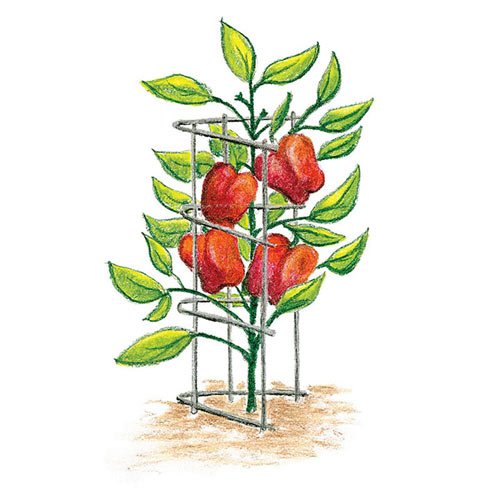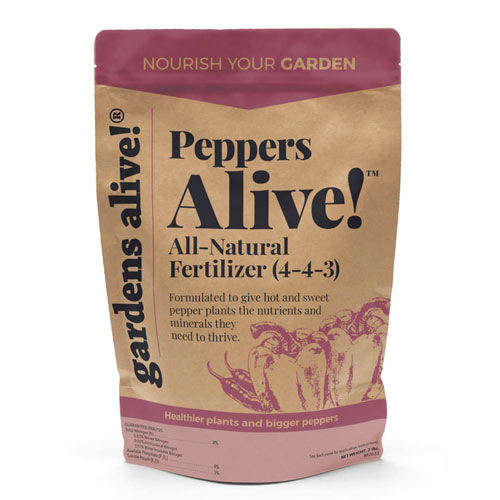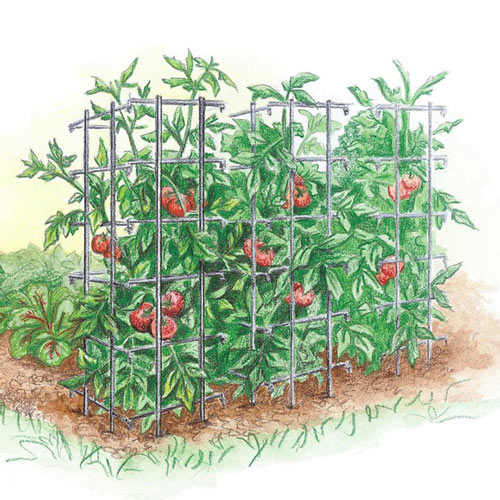More Seedy Suggestions for Fighting 'Produceflation'
-
Helpful Products from Gardens Alive!
-
 Pepper and Eggplant Support - Plant Trellis
Pepper and Eggplant Support - Plant Trellis -
 Peppers Alive!™ Fertilizer
Peppers Alive!™ Fertilizer -
 Tomato Cage - Plant Trellis
Tomato Cage - Plant Trellis
The punishing storms that lashed California for more than a month seem to have finally abated, but the damage is done. A major crop producer, California's Central Valley was not spared when the state was battered with 400 to 600 percent 'above the average' amount of rain. Not four to six times the average, but four to six HUNDRED times average. It's beyond even my hyper-active imagination.
I imagine that most of the current crop is lost; so look for lettuce and other produce prices to soar even higher. And the farm soils are almost certainly contaminated; these massive floods carry human waste, chemicals and other nasty stuff.
Two weeks ago, we urged you to stock up on lettuce seeds, which now seems like exceptionally good advice. Last week we discussed peas--another fun and healthy food to grow in the Spring.
But there are other cool-weather crops; radishes, for instance, are ready to harvest three weeks to a month after planting in decently warm soil. (I'll be growing the classic variety French Breakfast this Spring; although I doubt I'll have them for breakfast.) You MUST pull radishes about three weeks after the seeds sprout, otherwise the roots will get 'woody'. Luckily, radishes are a classic 'eat at any size' crop; so harvest with abandon and plant a fresh run every two weeks or so until hot weather arrives. The leafy greens are also edible, as are the seed pods that will appear if you wait too long to pick.
Two kinds; Spring radishes that mature FAST and fall varieties that are left in the ground to grow large for winter storage. Make sure you plant the right type for the season.
Cabbage, broccoli and other crops of Spring are also worth a look, but I want to talk about summertime standards today so you can order your seeds early--before all the good varieties are sold out.
Beans: Two basic types: Bush beans, which produce abundantly despite the plants only getting a couple of feet tall (great for containers!) and pole beans, which require a tall trellis. Note: some pole beans are self-supporting via their clingy tendrils and others flop down on the ground because you didn't pay attention to the descriptions when you ordered them.
A good number of fresh eating 'string bean' varieties are available as compact bush beans; I plant these in containers, so I don't have to bend to pick them. (I would call them 'green beans' but some types are purple or yellow.) Edible at any size, picking early and often yields the best flavor and a bigger harvest.
Beans meant to be stored dry for winter soups and stews (like Pinto, Black and Navy) are left on the vine until the pods turn brown and the beans inside the pod 'rattle' when you shake them. You can harvest some for fresh 'green bean' eating when the pods are young and slender, but do NOT pick them young if you want the largest amount of storage beans.
The classic Scarlet Runner bean attracts hummingbirds with its bright red flowers, and the dried beans are a dramatic black with purple highlights; or maybe they're purple with black highlights. Anyway, they're so pretty that people make jewelry out of them.
All beans are direct seeded outdoors after the soil warms up; and they benefit from the same inoculant you should have used on your peas.
Tomatoes: Again, two types. "Determinant" (or bush) varieties stay short and stocky and are great for large containers. "The Book" says that most of the fruits are produced in one large flush, but in my experience, they continue to flower and fruit if you pick them promptly when ripe.
"Indeterminant" tomatoes grow tall; up to 10 to 14 feet over the course of a season and will definitely continue to flower and fruit until frost (or you kill them; whichever comes first). Many classic heirloom varieties like Brandywine, Cherokee Purple and Mortgage Lifter are indeterminate and require STURDY support. If you're not willing to work for the reward, stick with indeterminate varieties. We'll have more about Summer's favorite fruit next week; and/or buy a copy of my book, "The You Bet Your Garden Guide to Growing Great Tomatoes" (Fox Chapel Publishing). It's a fun read and I think I make seventeen cents a copy.
Peppers: Again, two types: hot and sweet. Hot peppers come in an amazing variety of shapes, colors, and heat levels. Unless you're planning on diluting the heat with lots of vinegar by making a hot pepper sauce, try not to be the He-Man of Horticulture by growing nasty hot varieties like the notorious 'Ghost pepper'. Eating one of these monsters fresh is like taking the 'Tide pod challenge'.
Sweet: So-called "green peppers" are unripe, not at all sweet, and provide little nutrition. All green peppers will ripen up to a beautiful red, yellow, orange or chocolate color and are super-nutritious flavor bombs. Many require a LONG growing season, so pay attention to the 'days to maturity' listing. More on peppers next week as well.
Note: If you've never started seeds indoors, plan to purchase professionally grown plants at your local independent garden center or give the seeds to an experienced gardener to start for you. You got to walk before you can run.
Sunflowers: What a shock; there are two types! Who'd a thunk?! Sunflowers grown for seed like Russian Mammoth reach ten feet high and taller, and provide protein-rich seeds for winter survival and spitting. Ornamental sunflowers range in size from a tiny foot high to four or so feet and come in a wide range of dazzling colors. As the Pennsylvania Dutch say, grow some of these "chust for nice".
I imagine that most of the current crop is lost; so look for lettuce and other produce prices to soar even higher. And the farm soils are almost certainly contaminated; these massive floods carry human waste, chemicals and other nasty stuff.
Two weeks ago, we urged you to stock up on lettuce seeds, which now seems like exceptionally good advice. Last week we discussed peas--another fun and healthy food to grow in the Spring.
But there are other cool-weather crops; radishes, for instance, are ready to harvest three weeks to a month after planting in decently warm soil. (I'll be growing the classic variety French Breakfast this Spring; although I doubt I'll have them for breakfast.) You MUST pull radishes about three weeks after the seeds sprout, otherwise the roots will get 'woody'. Luckily, radishes are a classic 'eat at any size' crop; so harvest with abandon and plant a fresh run every two weeks or so until hot weather arrives. The leafy greens are also edible, as are the seed pods that will appear if you wait too long to pick.
Two kinds; Spring radishes that mature FAST and fall varieties that are left in the ground to grow large for winter storage. Make sure you plant the right type for the season.
Cabbage, broccoli and other crops of Spring are also worth a look, but I want to talk about summertime standards today so you can order your seeds early--before all the good varieties are sold out.
Beans: Two basic types: Bush beans, which produce abundantly despite the plants only getting a couple of feet tall (great for containers!) and pole beans, which require a tall trellis. Note: some pole beans are self-supporting via their clingy tendrils and others flop down on the ground because you didn't pay attention to the descriptions when you ordered them.
A good number of fresh eating 'string bean' varieties are available as compact bush beans; I plant these in containers, so I don't have to bend to pick them. (I would call them 'green beans' but some types are purple or yellow.) Edible at any size, picking early and often yields the best flavor and a bigger harvest.
Beans meant to be stored dry for winter soups and stews (like Pinto, Black and Navy) are left on the vine until the pods turn brown and the beans inside the pod 'rattle' when you shake them. You can harvest some for fresh 'green bean' eating when the pods are young and slender, but do NOT pick them young if you want the largest amount of storage beans.
The classic Scarlet Runner bean attracts hummingbirds with its bright red flowers, and the dried beans are a dramatic black with purple highlights; or maybe they're purple with black highlights. Anyway, they're so pretty that people make jewelry out of them.
All beans are direct seeded outdoors after the soil warms up; and they benefit from the same inoculant you should have used on your peas.
Tomatoes: Again, two types. "Determinant" (or bush) varieties stay short and stocky and are great for large containers. "The Book" says that most of the fruits are produced in one large flush, but in my experience, they continue to flower and fruit if you pick them promptly when ripe.
"Indeterminant" tomatoes grow tall; up to 10 to 14 feet over the course of a season and will definitely continue to flower and fruit until frost (or you kill them; whichever comes first). Many classic heirloom varieties like Brandywine, Cherokee Purple and Mortgage Lifter are indeterminate and require STURDY support. If you're not willing to work for the reward, stick with indeterminate varieties. We'll have more about Summer's favorite fruit next week; and/or buy a copy of my book, "The You Bet Your Garden Guide to Growing Great Tomatoes" (Fox Chapel Publishing). It's a fun read and I think I make seventeen cents a copy.
Peppers: Again, two types: hot and sweet. Hot peppers come in an amazing variety of shapes, colors, and heat levels. Unless you're planning on diluting the heat with lots of vinegar by making a hot pepper sauce, try not to be the He-Man of Horticulture by growing nasty hot varieties like the notorious 'Ghost pepper'. Eating one of these monsters fresh is like taking the 'Tide pod challenge'.
Sweet: So-called "green peppers" are unripe, not at all sweet, and provide little nutrition. All green peppers will ripen up to a beautiful red, yellow, orange or chocolate color and are super-nutritious flavor bombs. Many require a LONG growing season, so pay attention to the 'days to maturity' listing. More on peppers next week as well.
Note: If you've never started seeds indoors, plan to purchase professionally grown plants at your local independent garden center or give the seeds to an experienced gardener to start for you. You got to walk before you can run.
Sunflowers: What a shock; there are two types! Who'd a thunk?! Sunflowers grown for seed like Russian Mammoth reach ten feet high and taller, and provide protein-rich seeds for winter survival and spitting. Ornamental sunflowers range in size from a tiny foot high to four or so feet and come in a wide range of dazzling colors. As the Pennsylvania Dutch say, grow some of these "chust for nice".
-
Helpful Products from Gardens Alive!
-
 Pepper and Eggplant Support - Plant Trellis
Pepper and Eggplant Support - Plant Trellis -
 Peppers Alive!™ Fertilizer
Peppers Alive!™ Fertilizer -
 Tomato Cage - Plant Trellis
Tomato Cage - Plant Trellis







 Gardens Alive! & Supplies
Gardens Alive! & Supplies




